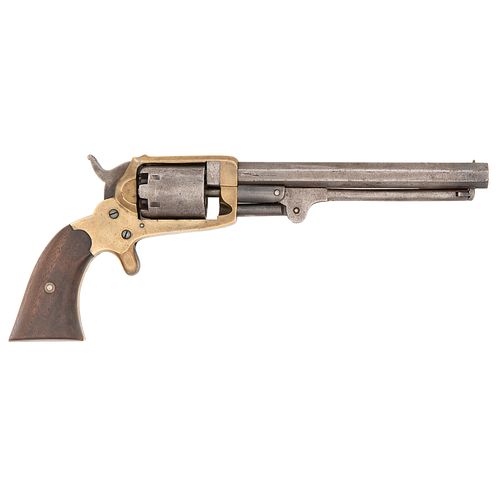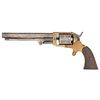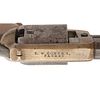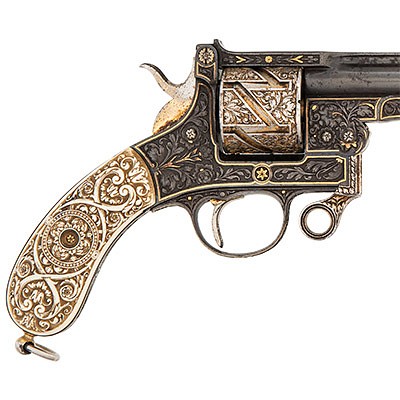Third Model Cofer Percussion Revolver
About Seller
6270 Este Ave.
Cincinnati , OH 45232
United States
With offices in Cincinnati, Cleveland and Denver, Cowan’s holds over 40 auctions each year, with annual sales exceeding $16M. We reach buyers around the globe, and take pride in our reputation for integrity, customer service and great results. A full-service house, Cowan’s Auctions specializes in Am...Read more
Two ways to bid:
- Leave a max absentee bid and the platform will bid on your behalf up to your maximum bid during the live auction.
- Bid live during the auction and your bids will be submitted real-time to the auctioneer.
Bid Increments
| Price | Bid Increment |
|---|---|
| $0 | $25 |
| $500 | $50 |
| $1,000 | $100 |
| $2,000 | $250 |
| $5,000 | $500 |
| $10,000 | $1,000 |
| $20,000 | $2,500 |
| $50,000 | $5,000 |
| $100,000 | $10,000 |
About Auction
May 6, 2020
Cowan’s is pleased to offer for its May 2020 Premier Auction an enviable collection of fine antique arms and military accessories. While the entire sale is indeed a showcase of rare and desirable items, several lots showcased in the May sale are of special interest to advanced collectors. Cowan's Auctions dawnie@cowans.com
- Lot Description
.36 caliber, 7.4375" octagonal barrel, S/N F. Brass frame, blued barrel, case hardened hammer, two-piece walnut grips. Single action, spur trigger, 6-shot percussion revolver. Top strap marked in two lines: T.W. COFER'S, / PATENT. Barrel marked in a single line: PORTSMOUTH VA. F assembly mark on bottom of barrel concealed by loading lever, on interior of frame under left grip, on cylinder arbor pin and on arbor pin retention screw. Loading lever hinge screw marked R. Sand cast brass frame with removable side plate on reverse, secured by two screws, allowing access to the action. Frame shows some minute casting flaws on the exterior and rougher workmanship and tool marks on the interior and on the bottom of the top strap. Iron barrel screwed into the solid brass frame with a .35" "nut" inside the frame to secure the barrel. Fixed notch rear sight cast integrally with the frame, brass post front sight about .3" from the muzzle. Seven-groove bore with extremely slow rate of twist. Cylinder arbor pin retained with a small screw through the left side of the frame similar to Whitney's in location, but relying upon pressure rather than a key way to secure the pin. Cylinder shows some minute streaky flaws and measures 1.78" in overall length, including the ratchet on the rear. The main body of the cylinder is nominally 1.49" in diameter. Cylinder chamber mouths vary slightly but nominally measure .365" but range from .362" to .369". Barrel measures nominally .368" at the muzzle.
Thomas W. Cofer (1828-1885) was a Portsmouth, VA based gunsmith working for his cousin P.D. Gwaltney prior to the outbreak of the American Civil War. Sometime circa 1860 or early 1861 Cofer appears to have started working on his own, under his own name as a very small number of arms, primarily shotguns are known with his name and his Portsmouth, VA address. Cofer later moved across the Elizabeth River and worked in Norfolk, so post-Civil War Cofer arms are Norfolk marked. Cofer was one of the first recipients of a Confederate States patent, and one of the very few to receive one related to weapons or small arms. On August 12, 1861 he received CS Patent #9 for a unique percussion ignition cartridge revolver with a two-piece cylinder. The patent primarily covered the two-piece cylinder design described above and the cartridges which the revolver would utilize. To students of firearms history the design appears to be either a brilliant evasion of the Rollin White or a clear violation of it. However, in either case, as a Confederate patent in a different "country" the point is moot. Total production of the Cofer Type I "Patent Cylinder" revolvers is not known, but to date only two examples, are known to exist, #1 and #7. Cofer went on to produce two other types of revolvers that were not directly related to his patent. The Type II was also a bored-through cylinder revolver using a percussion cap ignited cartridge, but this revolver used a one-piece rather than two-piece cylinder. This variant was of a smaller caliber and only one example exists, making the Type II variant an anomaly. The final version, or Type III revolver was a conventional percussion revolver with attached loading lever. All three used the same basic construction of a brass frame, octagonal iron barrel and spur trigger, and a single action mechanism with the overall appearance being that of a Whitney Navy revolver.
For many years the Cofer revolvers were regarded as a secondary Confederate revolver, with no known Confederate military purchases. Eventually researchers did discover a "contract" or at least receipts and payments records for a total of 82 revolvers that were ordered in January of 1862 by Captain Edgar Burroughs of the 5th Virginia Cavalry. These purchases have been attributed to the 5th Virginia Cavalry ever since, but after reading the original receipts and looking into Capt. Burroughs service history this cataloger has discovered that the attribution may not be completely correct. Edgar Burroughs, a 38-year old minister and farmer, was commissioned into Company A of the 5th Virginia Cavalry as a Captain on April 20, 1861. However, he was mustered out of that regiment on March 27, 1862. That same day he took command of Company B of the 14th Battalion of Virginia Cavalry, which was known alternately as "Burrough's Cavalry" or the "Chesapeake Battalion." On October 27, 1862 Burroughs was promoted to major and was transferred from the Chesapeake Battalion to the field and staff of the newly formed 15th Virginia Cavalry, which was created by consolidating the 14th and 15th Battalions of Virginia Cavalry. The first Cofer receipt selling revolvers to the Confederacy is dated January 18, 1862 and is for 17 revolvers at $40 each. It is accompanied by a note signed by Capt. Edgar Burroughs of the "Chesapeake Cavalry," which states the Burroughs had received from Cofer "seventeen revolvers, being part of eighty-two which he is to furnish my company." The payment by Capt. Smith Stansberry CSA Artillery, detached to the Ordnance Department, is dated February 5th, 1862. An accompanying note in the Cofer portion of the Confederate Citizen Files from the Confederate Ordnance Department memorializes the authorization for Burroughs to purchase revolvers in the Norfolk area for $40 each, because as the Ordnance Officer writing the note states; "this was $10 less than we were paying." A second receipt for 65 Cofer revolvers is dated May 31, 1862, some two months after Burroughs left the 5th VA Cavalry for his new command in the 14th Battalion of VA Cavalry. This payment receipt is also signed by Capt. Smith Stansberry. What is not clear is whether these additional revolvers were then delivered to Capt. Burroughs' old company in the 5th VA, his new command, or were simply issued as needed from the Confederate Ordnance Department.
The best documented Type III Cofer percussion revolver with Civil War provenance (ex-Cliff Young Collection) has its capture history written on the Confederate holster that accompanies it. This gun was captured by a Capt. Merrill of the 11th Maine Volunteer Infantry from a "Rebel Signal Officer" on 21 July, 1864. This suggests that the final batch of 65 Cofer revolvers delivered may have been issued generally in the Confederate army, rather than going to the 5th Virginia Cavalry. It is only conjecture, but is certainly possible that the January 1862 delivery of 17 guns was of the "cartridge" Type I revolvers, while those delivered some 4 months later were of the percussion Type III revolvers. As to date only 2 Type I cartridge guns are known and some 13 Type III percussion guns survive, it seems quite likely that this was the case. That would suggest a survival rate of about 12% of the Type I cartridge guns from the delivery of 17 revolvers and 20% of the 65 gun from the second, likely Type III delivery. These statistically similar survival ratios suggests that the bored through cylinder guns are almost certainly 5th VA revolvers from the January 18 delivery, while the percussion revolvers from the May 31 delivery may have seen more general issue in Confederate service. In either case, Cofer revolvers remain among the scarcest and most desirable of all Southern manufactured revolvers. Of the 13 known authentic Cofer percussion revolvers, only 8 are in private hands with the other 5 in institutional collections. As such, this represents a unique chance to own an extremely scarce secondary Confederate revolver.Good. Barrel and cylinder cleaned to a dull pewter gray, with mottled surface oxidation, discoloration and scattered pitting. Original brass a golden color, replaced removable sideplate a more toned bronze patina. Frame with old sobered repair at upper rear, above the rear of the cylinder. In addition to the modern made side plate, side plate screws, hammer, trigger ramrod plunger, and grips are modern replacements. Loading lever catch appears replaced as well. Markings remain clear on barrel and frame, action functions correctly. Cylinder chambers and bore are moderately pitted and show heavy oxidation. Replaced grips are good with some handling marks.Condition
- Shipping Info
-
Buyers are required to pay for all packing, shipping and insurance charges. Overseas duty charges are the responsibility of the successful Bidder. Be aware that for larger and/or valuable items, shipping charges can be substantial. - If there is no shipping amount on listed your invoice, you will need to make arrangements to pick up or ship your purchase through an alternative shipping company. Our shipping department can be contacted at 513.871.1670 (ext. 219) or email shipping@cowans.com. - Shipping charges include insurance for your order while in transit. If you have private insurance we will adjust your charge to include only packing and shipping. - Please allow 14 – 21 days after payment to package and ship your purchase as carefully as possible.
-
- Buyer's Premium



 EUR
EUR CAD
CAD AUD
AUD GBP
GBP MXN
MXN HKD
HKD CNY
CNY MYR
MYR SEK
SEK SGD
SGD CHF
CHF THB
THB


















